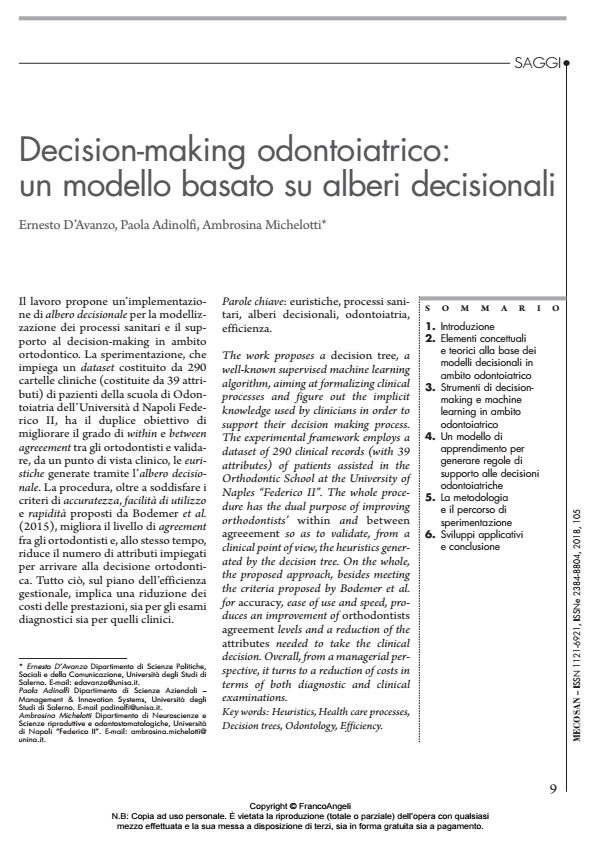Decision-making odontoiatrico: un modello basato su alberi decisionali
Titolo Rivista MECOSAN
Autori/Curatori Ernesto D’Avanzo, Paola Adinolfi, Ambrosina Michelotti
Anno di pubblicazione 2019 Fascicolo 2018/105
Lingua Italiano Numero pagine 16 P. 9-24 Dimensione file 428 KB
DOI 10.3280/MESA2018-105002
Il DOI è il codice a barre della proprietà intellettuale: per saperne di più
clicca qui
Qui sotto puoi vedere in anteprima la prima pagina di questo articolo.
Se questo articolo ti interessa, lo puoi acquistare (e scaricare in formato pdf) seguendo le facili indicazioni per acquistare il download credit. Acquista Download Credits per scaricare questo Articolo in formato PDF

FrancoAngeli è membro della Publishers International Linking Association, Inc (PILA)associazione indipendente e non profit per facilitare (attraverso i servizi tecnologici implementati da CrossRef.org) l’accesso degli studiosi ai contenuti digitali nelle pubblicazioni professionali e scientifiche
Il lavoro propone un’implementazione di albero decisionale per la modellizzazione dei processi sanitari e il supporto al decision-making in ambito ortodontico. La sperimentazione, che impiega un dataset costituito da 290 cartelle cliniche (costituite da 39 attributi) di pazienti della scuola di Odontoiatria dell’Università d Napoli Federico II, ha il duplice obiettivo di migliorare il grado di within e between agreeement tra gli ortodontisti e validare, da un punto di vista clinico, le euristiche generate tramite l’albero decisionale. La procedura, oltre a soddisfare i criteri di accuratezza, facilità di utilizzo e rapidità proposti da Bodemer et al. (2015), migliora il livello di agreement fra gli ortodontisti e, allo stesso tempo, riduce il numero di attributi impiegati per arrivare alla decisione ortodontica. Tutto ciò, sul piano dell’efficienza gestionale, implica una riduzione dei costi delle prestazioni, sia per gli esami diagnostici sia per quelli clinici.
Parole chiave:Euristiche, processi sanitari, alberi decisionali, odontoiatria, efficienza.
Ernesto D’Avanzo, Paola Adinolfi, Ambrosina Michelotti, Decision-making odontoiatrico: un modello basato su alberi decisionali in "MECOSAN" 105/2018, pp 9-24, DOI: 10.3280/MESA2018-105002